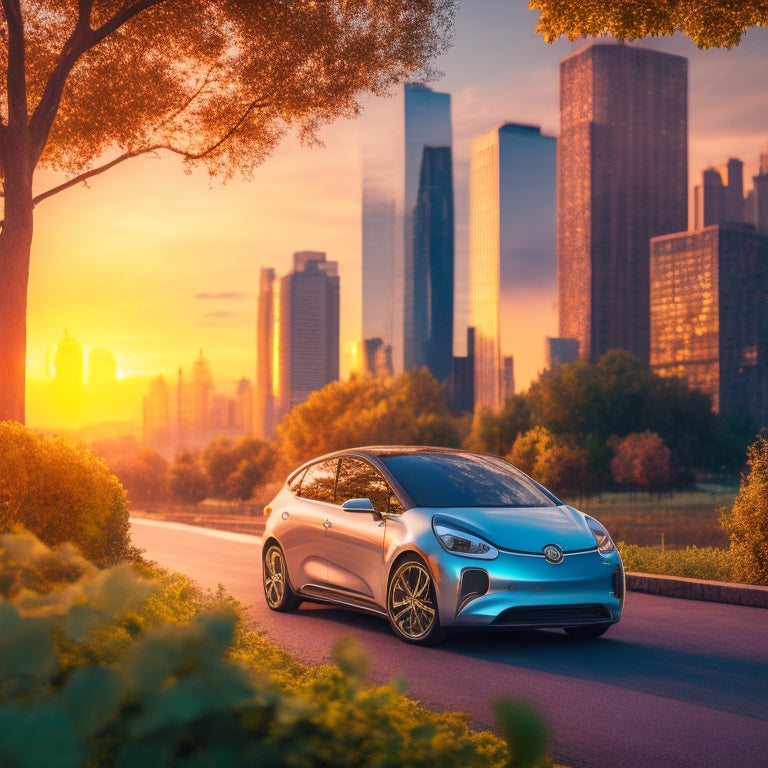
Master Electric Car Tips and Tax Benefits
Share
Optimizing electric vehicle (EV) ownership requires understanding charging essentials, benefits, and tax incentives. Master EV charging by grasping Level 1, 2, and 3 power outputs, and follow tips like keeping vehicles plugged in and avoiding overcharging. Enjoy enjoyable driving experiences, lower operating costs, and reduced environmental impact. In the U.S., claim up to $7,500 in tax credits by verifying eligibility and filing Form 8936 with the IRS. To unlock the full potential of EV ownership, it's essential to understand the intricacies of charging, incentives, and tax credits - explore further to discover how to maximize your benefits.
Key Takeaways
• Understand the three electric car charging levels: Level 1 (standard outlet), Level 2 (240-volt), and Level 3 (DC Fast Charging) for optimal charging.
• Maximize your EV tax credits by verifying eligibility, claiming up to $7,500, and filing Form 8936 with the IRS.
• Enjoy EV benefits, including an enjoyable driving experience, lower operating costs, and a reduced environmental impact with zero tailpipe emissions.
• Optimize your EV experience by keeping your vehicle plugged in, avoiding overcharging, and parking in the shade to protect the battery.
• Take advantage of government incentives, including rebates and lower operating costs, to promote eco-friendly transportation and reduce greenhouse gas emissions.
Electric Car Charging Essentials
When it comes to electric car charging, understanding the different charging levels and their corresponding power outputs is essential for maximizing battery life and minimizing charging times.
There are three charging levels: Level 1, Level 2, and Level 3. Level 1 charging, which uses a standard household outlet, is the slowest method, providing 4-5 miles of range per hour.
For efficient charging and ideal battery maintenance, it is important to keep the vehicle plugged in, avoid overcharging, and limit the use of Level 3 charging. Additionally, parking in the shade can help protect the battery.
EV Benefits and Incentives
Electric vehicles offer numerous benefits, including a more enjoyable driving experience, lower operating costs, and a reduced environmental impact, making them an attractive option for many consumers. One of the most significant advantages of EVs is their reduced environmental impact, producing zero tailpipe emissions and minimizing greenhouse gas emissions. Governments worldwide recognize the importance of promoting eco-friendly transportation, offering incentives to encourage EV adoption.
| Incentive | Description |
|---|---|
| Government Rebates | Up to $7,500 in the U.S. for qualifying vehicles |
| Lower Operating Costs | Reduced fuel and maintenance costs |
| Environmental Benefits | Reduced greenhouse gas emissions and air pollution |
Maximizing Your EV Tax Credits
To maximize the financial benefits of going electric, it is crucial to understand how to claim and optimize EV tax credits, which can amount to a substantial $7,500 in the United States. This incentive is designed to encourage the adoption of eco-friendly vehicles, and knowing how to claim it can greatly reduce the cost of owning an electric vehicle.
-
Verify tax credit eligibility by checking the manufacturer's sales threshold, as the credit phases out after 200,000 qualifying vehicles are sold.
-
Claiming incentives requires filing Form 8936 with the IRS, attaching the manufacturer's certification, and keeping records of the vehicle's purchase and battery capacity.
-
The credit amount is calculated based on the vehicle's battery capacity, with a minimum of $2,500 for vehicles with a 5 kWh capacity.
-
Leased vehicles are also eligible, with the credit passing to the lessee.
-
Consult a tax professional to ensure accurate claiming of the credit.
Frequently Asked Questions
Can I Charge My Electric Vehicle in the Rain?
'Rainy days won't dampen your electric vehicle's charging experience. Rest assured, modern charging systems are designed with water resistance and safety precautions in mind, incorporating weather-proofing and electrical surge protection to guarantee safe and efficient charging, even in wet conditions.'
How Do I Store My EV Charging Cables When Not in Use?
When not in use, store your EV charging cables in a dry, cool place, utilizing cable management systems or cord organization tools to prevent damage, tangling, and corrosion, ensuring safe and efficient charging.
Are Electric Vehicles More Prone to Rust Than Gas-Powered Cars?
"Rain or shine," electric vehicles are built to withstand the elements, with rust protection and moisture-resistance measures in place to prevent corrosion, making them no more prone to rust than their gas-powered counterparts.
Can I Tow an Electric Vehicle if It Runs Out of Charge?
In the event of a depleted battery, electric vehicles can be towed using a flatbed truck or wheel-lift tow truck, ensuring the vehicle is in neutral and the parking brake is disengaged, while also utilizing emergency roadside services for assistance.
Do Electric Vehicles Have Spare Tires and Changing Equipment?
While electric vehicles often lack spare tires, some models provide tire-inflation kits or sealant-based solutions. In case of a flat, roadside assistance services can aid in towing or on-site repairs, alleviating concerns about being stranded.
Related Posts
-

3 Best Solar-Powered Biodegradable Accessories for Your Home
You're taking a significant step towards a more sustainable lifestyle by incorporating solar-powered biodegradable ac...
-

Why Merge Earth's Heat With Sun's Energy?
You're about to utilize the full potential of renewable energy by combining the Earth's natural heat with the Sun's a...
-

7 Solar-Safe Window Solutions for Earth-Conscious Homeowners
As an earth-conscious homeowner, you're likely keen to find solar-safe window solutions that align with your values. ...


